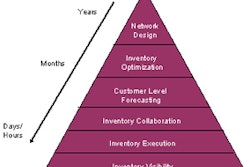
By Karen West
For years, chief supply chain officers have been urged to become strategic partners to their CEOs, wield the supply chain as a potent competitive weapon and join the conversation at the top leadership table. Many have done so, but they know that to succeed they must drive the strategic, global perspective far deeper into their far-flung supply chain organizations by developing the business partnering skills of their mid-rank supply chain personnel.
That can be a tall order.
Many supply chain personnel have been confined to narrow roles such as purchasing and contract writing. They have not had access to the kind of generalist business experience that would enable them to partner with business unit heads and other executives in their day-to-day activities. In large companies, with complex organizations, midlevel supply chain executives often focus only on the business to which they are locally attached, with little global perspective and with the chief aim of seeing that the business is supplied at the lowest cost. Further, many have had little opportunity to develop the leadership and influencing skills needed to become trusted business partners.
These limitations may be self-imposed or may be imposed by their companies, but nevertheless these executives represent a huge reservoir of untapped talent. If given the chance, they can help make the visions of chief supply chain officers an everyday activity at every level of their companies — taking a global perspective, proactively bringing business opportunities to their unit leaders and inspiring other supply chain personnel to follow their example.
Adding Value to the Business
In a world where business moves at warp speed, most companies need these new-breed supply chain executives more than ever but lack the time to devote years to developing them. That was the dilemma faced by one of the world's largest industrial companies, with operations and business units around the world, organized both geographically and by segment of the value chain.
Initially, the company (which must remain unnamed for reasons of confidentiality) didn't understand the real nature of the challenge. Because external benchmarking had revealed that they lagged competitors in terms of supply chain costs, leaders thought that they simply needed to wring more costs out of their operations. But they soon realized that simply cutting costs in procurement wasn't the real problem. They needed genuinely global supply chain management that encompassed not only costs but also value and the strategy, plus the ability to extract business opportunities from the supply chain. That, in turn, meant not necessarily better procurement, but supply chain management executives who could think globally and act as business partners locally.
Feeling it had little time to lose, the company undertook what might be called an extreme makeover of its supply chain executives, transforming midlevel executives into strategically minded business partners in a remarkably short time.
To guide the project, the company first created a "board" representing various stakeholders in the project, including heads of operations, key human resources executives and those highly skilled in project management who knew the business well. A project team was formed that consisted of company representatives and outside consultants skilled in change management, talent assessment and leadership development. The team set out to identify the people throughout the supply chain organization as well as external candidates who might have the potential to make the transformation to the new role.
The team first developed a model of the technical and leadership competencies the new role would require. Technical competencies included:
- Experience inside and outside the industry
- Experience developing a market sector strategy
- Ability to select best value in the supply market
- An understanding of the supply market and associated risks
- Experience contracting, including planning and executing contracts
- Financial skills
- Project management skills
The leadership competencies included the ability to:
- Exhibit drive
- Engage and lead others to be their best
- Build internal and external relationships
- Execute performance management and metrics for managing people
- Be commercially minded
- Think strategically and proactively regarding their role
These competencies were carefully weighted, with finely calibrated scoring criteria for each. Ideal candidates would score high in both the technical and leadership dimensions.
The team assessed approximately 350 internal personnel spread over 10 business units globally, with the addition of approximately 100 external people. The assessments included behaviorally based interviewing focused on technical competencies and in-depth interviewing designed to understand each individual's leadership potential and personal motivation. In addition, each individual was tested for problem-solving skills, relationship styles and thinking preferences. Feedback sessions, based on the interviewing and testing, were also conducted in order to refine the assessment. The goal was to determine who met minimal standards for the new role, who didn't and the development potential for individuals in both groups.
These results were conveyed to the supply chain "board," which then made decisions about who would move forward in the new roles and who might find other roles. Having identified the right people, the team then executed an extraordinary rollout designed to get people to cast off the old ways, embrace the new and adopt individualized development plans — all in just three days, rather than over a period of months.
On the first two days, the supply chain leaders of each business unit and their direct reports set goals for the transformation and focused on how they would lead it. They digested feedback from stakeholders outside the supply function about their performance. They also engaged in intense one-on-one leadership development conversations with project team consultants and reviewed the principles of mentoring, coaching and feedback so that they would be prepared to help facilitate the transformation.
On the third day, the direct reports of the supply chain leaders rolled out the program to their direct reports — the middle managers throughout the business unit. These critically important personnel were given ownership for developing the capability of their people in order to optimize individual and team performance. They were provided with coaching tools for tailoring advice and supporting individuals and teams. They also engaged in intense one-on-one sessions with project consultants, and each left the meeting with an individually tailored plan for the development of the personal and professional skills they would need to succeed.
What this barebones account misses is the depth and rapidity of the individual and collective transformation of the function. Most people naturally resist change. But in just three days in each business unit, the leadership of the function, the middle managers and the individual contributors genuinely let go of the old way of doing things. They enthusiastically embraced their new roles and an ongoing process, which included supply chain and business stakeholders, for measuring progress.
As a result of the makeover, the supply chain function has moved from adding value to the function to adding value to the business. Instead of varying degrees of alignment with the business, the supply chain function is aligned with strategy and operational needs, while challenging the thinking of the business and creating tension to achieve the best value. The function now gets involved early in the business planning process and agrees on fundamentals that prevent delays in the operation of the business. Perhaps most importantly, the function now has the ability to train, coach and develop its supply chain management and line expertise to proactively add value to the business — now and into the future.
About the Author: Karen West is a managing consultant at YSC, a global consultancy that focuses on transforming organizational capability. She can be reached at [email protected].


















